Modules 18-21 F/R text
See also chapter 5 in Withgott:
Evolution, species interaction, communities and species interactions
Lab: Predator prey phase delay (bunnies and lynxes)
Module 18-abundance and distribution
Start with this:
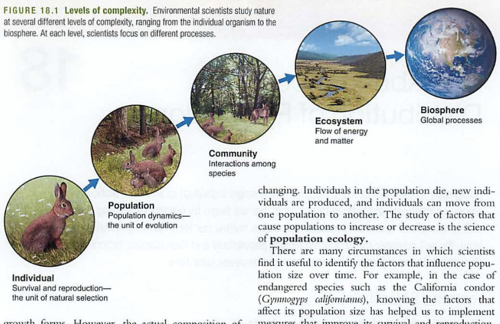 |
|
Click for full-size image |
A crude example of this might be:
individual-you
population-HPA students
community-HPA
ecosystem-education
biosphere-the world
or:
some rabbit individual
some of the rabbit's friends, a population of rabbits
rabbits and the things they eat and eat them-community
ecosystem-the plants that support both ends of this process
biosphere-the planet
We covered ecosystem energy and matter a few weeks ago, this chapter is about population ecology.
--------------------
Population dynamics
Notation: Population size is represented as N (note not "n"): population size within a defined area at a specific time (brings in migration).
So, we could say the student population of HPA would be all students here this year, 2022-2023
Check out the diagrams on population distribution: random, uniform and clumped. Important vis a vis biodiversity
Structures: age and gender (sex)
- Density dependent factor: e.g. food or reproductive rate in rats (more rats, lower "fecundity" or birthrate)
- Something that influences reproduction or survival...
- Density independent factors: storms, disasters, fires (note density independent: one bambi or 100 bambi all perish in the same fire)
- Limiting resource: usually food, but could include space, nutrients, etc.
- Carrying capacity: K (note not "k"): how many individuals an environment can support
Module 19: growth models
Imagine you are a happy bacteria, or rabbit, with lots of food, land and no predators. Your population growth curve might look like this:
This is called exponential growth, or "J shaped growth"
Note that it has no end, or limiting factor.
Small r is the growth rate. If you have had physics (yay!) this is usually "k" in some examples, or related to RC decay/growth.
Learning this equation is VERY useful.
Note that it depends on two things:
the starting amount in the population (No)
and the growth rate (r)
Here is an example:
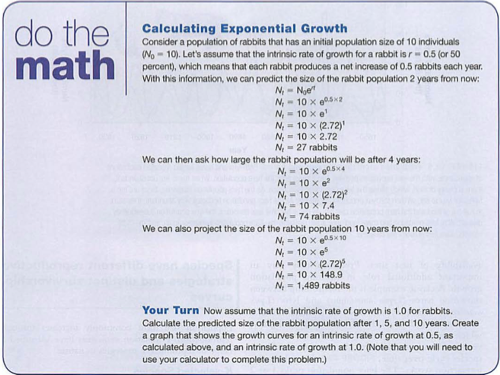 |
|
Click for full-size image |
You might also find this link useful:
Many systems follow J shaped exponential growth until they run out of food or space, then there is overshoot and die-off:
A more ideal version of this is the S shaped curve, called logistic growth:
Here is a formula for logistic growth that we'll discuss:
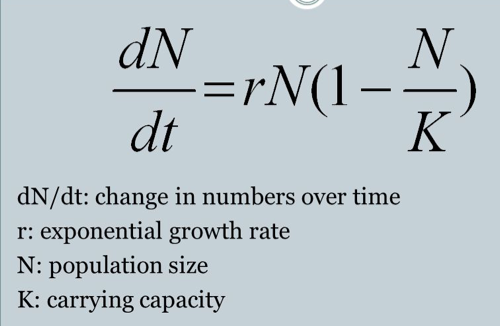 |
|
Click for full-size image |
Don't be intimidated by this formula...
dN/dt is just delta N over delta t, or the ∆ in number over the ∆ in time, (∆ means change)
or the rate of population growth (some of you may see this as the slope of the S curve)
Note that when the ratio N/K is very small or close to zero, the stuff in the parentheses becomes 1, so the formula is rate = rN, or J curved exponential growth.
Recall: J curved exponential growth only depends on starting population and reproductive rate.
As N/K nears one (number of critters equals carrying capacity) the term in the parentheses becomes zero, so no growth.
Note also that if N/K is GREATER than one, the growth rate (slope of the curve) become negative. This is overshoot and die off.
------
Logistic growth worksheet
First: exponential growth:
Imagine 10 imaginary rabbits (No=10)
Assume r = 0.5 (50 percent growth rate, or each rabbit makes 0.5 rabbits per year)
Find the population 2 years later:
Nt = Noe^rt
Nt = 10e^0.5*2
Nt = 27 rabbits
After 4 years:
After 10 years:
———
Next, use the logistic growth formula, same data, with a carrying capacity (K) of 100:
Small population: 10 rabbits
∆N/∆t = rN(1-N/K)
= 0.5*10(1-10/100)
= 5(1-0.1)
= 5(0.9)
= 4.5 rabbits per year
Find the rabbits per year for these populations:
Medium population: 27 rabbits
Near K: 74 rabbits
Above K: 1489 rabbits
quiz (you may use your worksheet only)
- 30 rabbits live on an island with carrying capacity 200. They reproduce at a rate of 0.5 per year. How many rabbits will be on the island after 3 years? (hint: you would do the calculation three times-this is only an estimate though, the true formula would be a bit more complex)
- What will be the slope of the growth curve at this point?
Next: predator/prey phase diagrams
Check this out:
 |
|
Click for full-size image |
Note the phase (timing) relationship between the abundance of the food and the population of the prey, then the predator.
Predator Prey Lab:
Worksheet: (uses Numbers application)
Worksheet: excel version:
Questions:
Now we can discuss generalizations of r and K strategists:
Note: r comes from small r (growth rate) in the growth formula, while K comes from large K in the same formula (carrying capacity):
Where do you fit in? How about Nemo?
Birds also fall into type II (no pun intended), as they randomly crash into stuff...
There is a fourth type: deer. How would you imagine this curve?
Related:
Another reason why genocides are so damaging to cultures: If an oral tradition (e.g. Hawaiians) are decimated by smallpox for example, it is the very old (the holders of the legends and history) and the very young (those who have time to listen, not work, and will then grow up and tell their kids) that are gone. This is a sort of cultural bottleneck...
Module 20: Community ecology
Competitive exclusion principle: two species competing for the same resources cannot co-exist, leads to...
Resource partitioning: time, space, type of food (one species picks one, the other survives)
Relationships:
Predation: predator and prey, one lives, the other dies
Symbiotic:
Mutualism: both benefit
Commensalism: one benefits, no harm to the other
Non-symbiotic:
Parasitism: one benefits, harm to other
keystone species vs. indicator species
Keystone species-many others depend on it, removal has an impact much greater than their relative population
e.g. beavers: create habitat for others (dams), so they are also "keystone engineers", only they don't wear funny hats.
Here's what a keystone looks like:
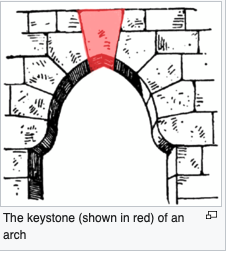
In architecture, if you remove the keystone, the arch collapses. Cool term, right?
This is different from a capstone (seniors might like this): a capstone is what you put on top of a finished structure
Another example: "keystone predators" e.g. sea stars, which eat mussels, clearing space on rocks for other species
Indicator species-signal health of a system, like some fish or worms signify water quality, also known as "bioindicators"
Succession: one species takes over another in time
Module 21: Community Succession
Primary succession: From bare rock, no soil: (e.g. lichen)
These hold moisture and some sort of matrix (e.g. soil) so that others can then grow
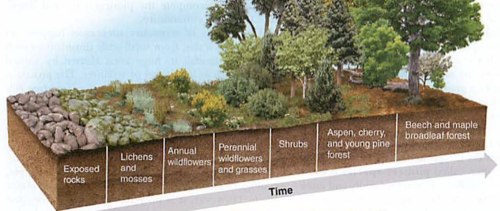 |
|
Click for full-size image |
You might imagine driving from the Kohala coast up to Waimea, seeing bare lava along the coast, then fountain grass, then small bushes, then trees along the stream, then larger trees away from the stream.
Water is the key to life, so anything that can trap and hold water (e.g. soil) can support life.
Secondary succession: from disturbed area with soil (e.g. after a fire)-there is soil, but no plants, growth here might be quicker than primary sucession.
Pioneer species: arrives first, sets up reliable system of water and matrix
Climax community: stable, well evolved ecosystem, e.g. old growth forest, able to survive disasters (e.g. fire)
Aquatic succession: from stream (flowing water) to pond (less flow) to shallow pond (even less flow) to marsh (mostly mud)
Island biogeography (like here in Waimea): habitat size AND distance from others influences diversity (e.g. birds)
This was Darwin's whole gig, also some folks off the coast of Chile, often with birds involved.
Check out an alternate presentation of these in the Withgott text, with a special section about our island:
http://physics.hpa.edu/physics/apenvsci/texts/withgott/withgott%206e/3-4.pdf
Frog book chapter 5:
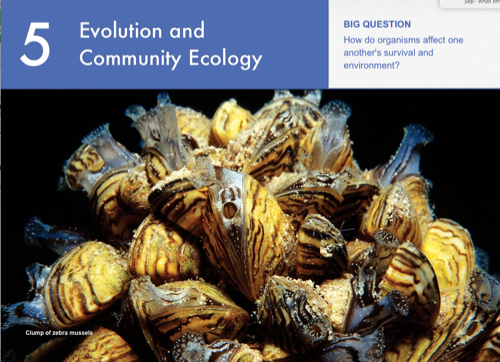 |
|
Click for full-size image |
Questions:
- What three things in order are necessary for evolution to succeed?
- What are the characteristics of an r specific species. Give an example.
- What are the characteristics of a K specific species. Give an example as well.
- The population of wolves may rise and fall along with rabbits, but not at the same time. Explain why.

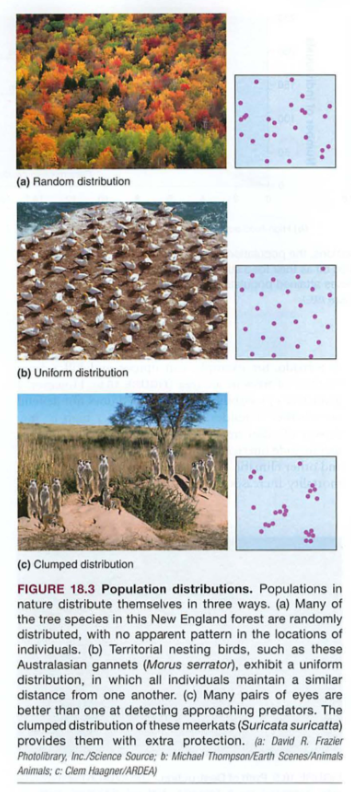
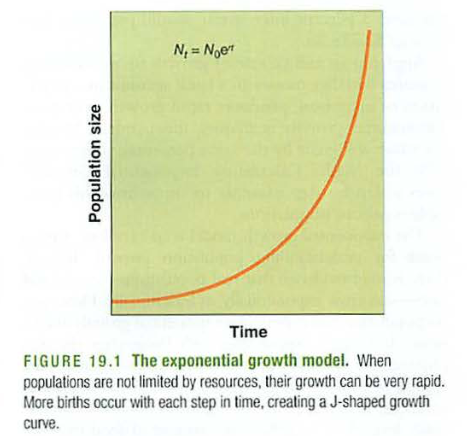

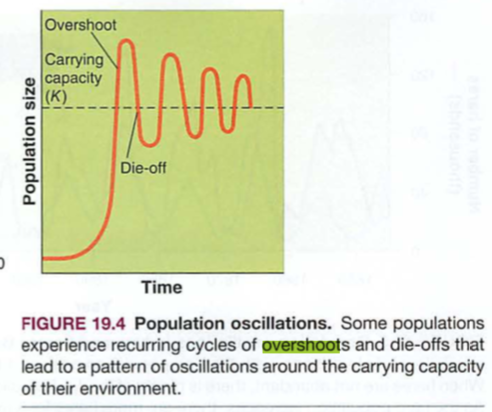
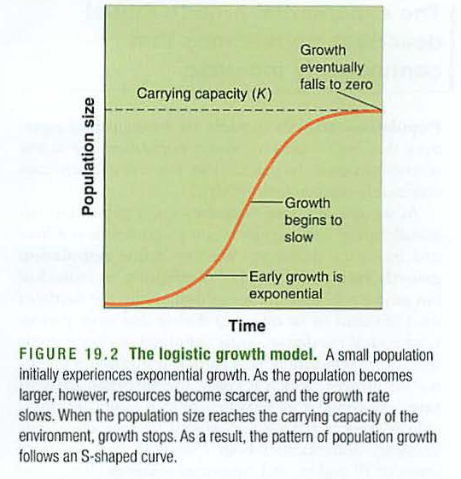

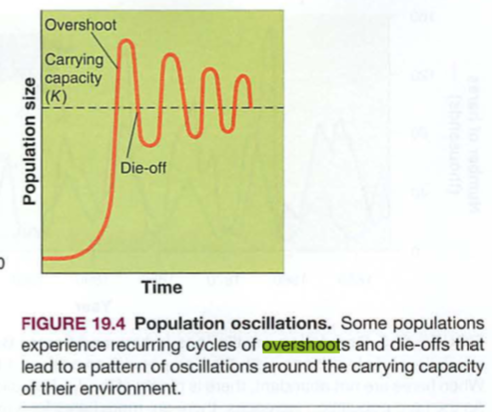

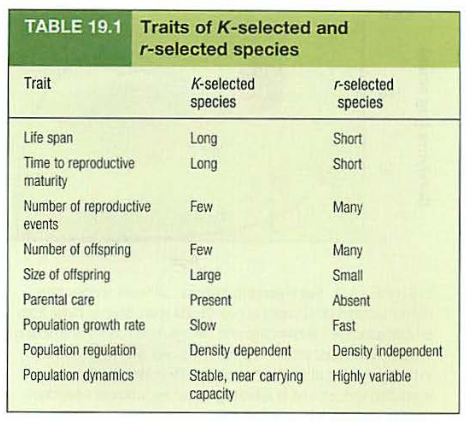
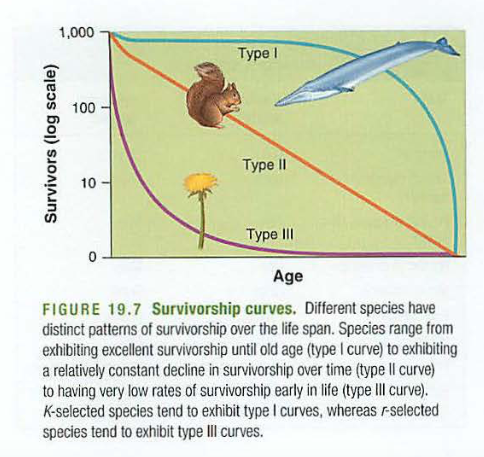
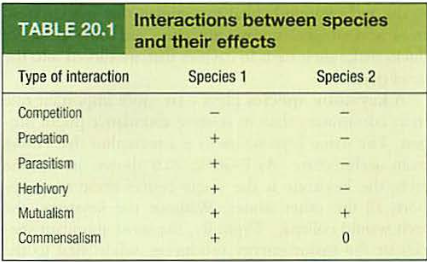









Comments